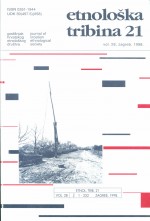Seoski kućni prostor u zrcalu rituala
Rural Housing Space in the Mirror of Rituals
Author(s): Aleksandra MurajContributor(s): Valentina Gulin Zrnić (Translator)
Subject(s): Customs / Folklore, Architecture, Cultural Anthropology / Ethnology, Rural and urban sociology, 19th Century, Pre-WW I & WW I (1900 -1919), Interwar Period (1920 - 1939), WW II and following years (1940 - 1949)
Published by: Hrvatsko etnološko društvo
Keywords: culture of habitation; customs; Banija;
Summary/Abstract: In the light of the contemporary anthropology of architecture the author attempts to examine the relations of rural population living in a particular geographic region towards the space they inhabit. Since the author raises the issue of mentioned relations in past times (in the period at the end of the 19th and the first half of the 20th century) it was not possible to conduct a direct analysis hence the author resorts to an indirect approach. The relation is considered in its social dimension by means of symbolic codes inveterate in a particular community and applied on two occasions: in the process of integration when an adult enters a family and in the process of segregation from a deceased family member. The research is based on ethnographic and other data on architecture and on customs related to wedding and death by the peasants in Banija. The gathered data suggest that in the mentioned period the rural community was predominantly traditional and even conservative, marked by archaic agricultural economy with high rate of autarchy, prevailed communication was oral and the rural community participated in collective celebrities to a large extent. Peasants from Banija lived in the houses built out of natural materials (timber material prevailed), with simple distribution, poor furniture and fittings and without modem technical devices. Residential buildings together with farm-building organized in a yard around the house were most frequently girded by wooden fence. The house was fulfilling basic residential and working needs but it was also a stage for various events in which a broad social community participated, especially on occasions which ruptured ordinary life of an individual or whole family .The analysis of a part of wedding customs that relate to bride’s arrival into bridegroom’s house indicates the existence of some particular places or significant border lines where integrative procedure takes place while crossing territory and local area. Within a procedure of arrival there are some consecrated topoi: a space next to house door, stair admittance, door step, kitchen fire-place, table and a place under the main beam in a room. The credibility of these places is tested also in an opposite occasion when a family separates from a deceased member. The analysis confirms that in mentioned situations some procedures take place in just the same topoi (place under the main beam, door-step, fire-place, table, yard lines) in order to cut the connection between a deceased member (his/her soul) and home. For the people who lived in the villages of Banija in the first half of the 20th century these particular places in their living space had a deeper significance than is revealed by their primary practiced function. They point to the significance of a house that not only fulfills different functions but is also an inescapable territory of people’s social life.
Journal: Etnološka tribina : Godišnjak Hrvatskog etnološkog društva
- Issue Year: 28/1998
- Issue No: 21
- Page Range: 45-58
- Page Count: 14
- Language: Croatian

